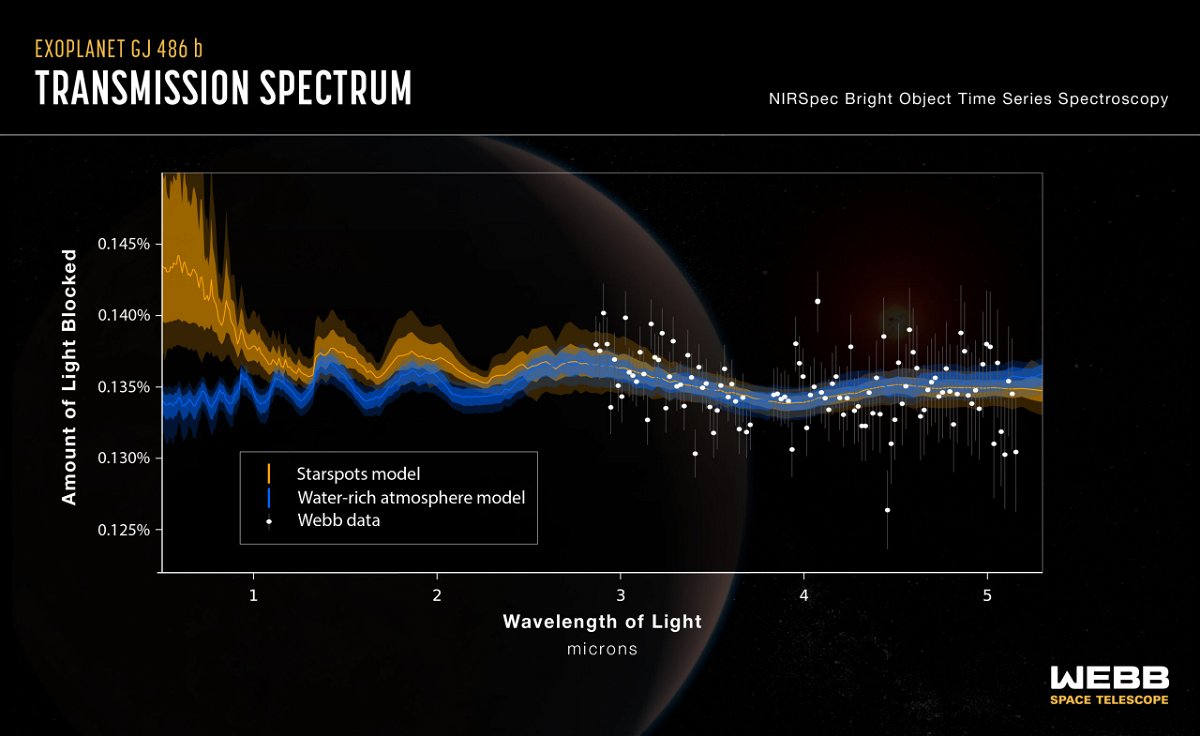Webb telescope detects mysterious water vapor in a nearby star system

By Ashley Strickland, CNN
The James Webb Space Telescope has detected water vapor around a rocky exoplanet that orbits a star located 26 light-years away from Earth.
Now, astronomers are trying to determine whether that water vapor is an indicator of what would be the first-known presence of an atmosphere around a rocky exoplanet.
Small, cool red dwarf stars are the most common stars in the universe. The exoplanets found in the “habitable zone” — the perfect distance from a star to allow the planet to be warm enough to host liquid water on its surface — often orbit red dwarfs very closely since they aren’t as warm as the sun.
Red dwarf stars lash out with ultraviolet and X-ray radiation that has the potential to demolish fragile layers of gas, leading scientists to question whether rocky planets orbiting them can maintain — or regain — atmospheres.
Astronomers observed a hot, rocky exoplanet called GJ 486 b using the Webb telescope. The planet is about 30% larger than Earth and has much stronger surface gravity than our planet.
The planet is so close to its host star that GJ 486 b completes one orbit around it every 1.5 Earth days, and this proximity heats the planet to a surface temperature of 800 degrees Fahrenheit (430 degrees Celsius). Astronomers believe the planet is tidally locked, meaning that one side always faces the star while the other is a permanent night side — similar to how the moon orbits Earth.
Although the scorching temperatures make the planet too hot to be habitable, observations of GJ 486 b with Webb’s Near-Infrared Spectrograph revealed hints of water vapor. A study detailing the findings has been accepted for publication in The Astrophysical Journal Letters.
The presence of water vapor could suggest that GJ 486 b somehow has an atmosphere, despite its heat and proximity to the star.
Water vapor mystery
While water vapor has previously been detected on gaseous exoplanets, scientists have yet to find an atmosphere around a rocky exoplanet — doing so would be a landmark event, since that would make it similar in a way to planets in our solar system like Earth and Mars, which are considered rocky.
“Water vapor in an atmosphere on a hot rocky planet would represent a major breakthrough for exoplanet science. But we must be careful and make sure that the star is not the culprit,” said study coauthor Kevin Stevenson, principal investigator on the Webb observing program at the Johns Hopkins University Applied Physics Laboratory in Laurel, Maryland, in a statement.
The team observing GJ 486 b watched as the planet crossed in front of its star twice, and then they used multiple methods to analyze the data captured by the telescope’s instruments.
When planets pass in front of their stars, also known as a transit, the starlight can filter through a planet’s atmosphere and highlight the chemical traces of different gases and elements. The results from the Webb data analysis pointed to water vapor being present around GJ 486 b.
But astronomers are taking care with their interpretation of the findings because it’s possible that the water vapor is connected to the star itself.
“We see a signal, and it’s almost certainly due to water. But we can’t tell yet if that water is part of the planet’s atmosphere, meaning the planet has an atmosphere, or if we’re just seeing a water signature coming from the star,” said lead study author Sarah Moran, postdoctoral research associate at the University of Arizona in Tucson, in a statement.
Water vapor even exists on our sun in sunspot regions. Sunspots or starspots are areas that appear dark on stars because they’re cooler than other parts of the surface.
Since the red dwarf star hosting GJ 486 b is much smaller and cooler than the sun, it may contain even more water vapor in its starspots — enough to create a signal that could be misinterpreted as a planetary atmosphere surrounding the closely orbiting exoplanet, according to the researchers.
“We didn’t observe evidence of the planet crossing any starspots during the transits. But that doesn’t mean that there aren’t spots elsewhere on the star. And that’s exactly the physical scenario that would imprint this water signal into the data and could wind up looking like a planetary atmosphere,” said study coauthor Ryan MacDonald, a NASA Sagan Fellow at the University of Michigan in Ann Arbor, in a statement.
The heat and radiation from the star would likely erode GJ 486 b’s potential atmosphere over time. If the exoplanet currently has an atmosphere, it would need replenishment from a constant source, like steam from volcanoes.
Future observations of the planet using different instruments on the Webb telescope could reveal additional details about the source of the water vapor.
“It’s joining multiple instruments together that will really pin down whether or not this planet has an atmosphere,” Stevenson said.
The-CNN-Wire
™ & © 2023 Cable News Network, Inc., a Warner Bros. Discovery Company. All rights reserved.